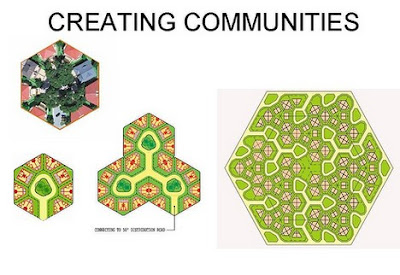Time to re-engage with the amazing eco-planning happening around the globe. We took a tongue-in-cheek look with the Suburb Eating Robots, as well as a more in depth and serious look at Auroville, a visionary community in southern India. For a great follow-up to this project, read Brice Maryman’s first-person account of a design-build trip to Auroville, complete with video documentary that gives a great visual and personal account of the process. Looks like fun.
Taking mass-customization to a greater extend is the very unique ORDOS 100 collaborative project happening in Inner Mongolia. Led my Herzog & de Meuron, the project involved a unique platting of 100 parcels (by FAKE Design), and the subsequent selection by HdM of 100 architects from around the globe to design the individual villas.
An overview from the website: “The scope of the project is to Develop 100 hundred villas in Ordos, Inner Mongolia, China, for the Client, Jiang Yuan Water Engineering Ltd. FAKE Design, Ai Wei Wei studio in Beijing, has developed the masterplan for the 100 parcels of land and will curate the project, while Herzog and de Meuron have selected the 100 architects to participate. The collection of 100 Architects hail from 27 countries around the globe. The project has been divided into 2 phases. The first phase is the development of 28 parcels while the second phase will develop the remaining 72. Each architect is responsible for a 1000 square meter Villa.”
The most poignant comment about the layout comes via Archidose: “Looks like suburbia in Mongolia to me. Looks like it was designed by the client, not by the artist who collaborated with Herzog & de Meuron on the Bird’s Nest, among other projects. It’s apparently surrounded by more of the same, but it’s disappointing nevertheless. The green space (in grey, running from the body of water on the left to the cluster of darker-grey cultural buildings on the right) attempts to salvage things, though its scale is a bit paltry.”
It will be interesting to see how the build-out happens with the forced eclecticism. Also interesting is the concept of exporting the very western idea of suburbia, which is permeating China, Pakistan, Argentina, Europe, and Latin America. As mentioned in the USA Today article: “The suburbs represent, almost like a cliché, the American dream,” says New York architect Kevin Kennon, who has worked in China and Pakistan and is the executive director of the Institute for Architecture and Urban Study. “I can own a piece of land, I can have my house on that land. … It allows people to point to something that they own and distinguish it from other houses, even if they look the same.”
One project that may offer a glimpse of both what ORDOS 100 will turn up architecturally – and a way of combating the homogenization that seems typical of suburban development is the Next-Gene20 project for the island of Taiwan. Via Archinect: “MVRDV, Kengo Kuma and Julien De Smedt are among the 20 architects designing 20 villas on the island of Taiwan. The Spaniard Fernando Menis, Berlin and LA based Graft, as well as 10 Taiwanese practices are among the other architects taking part.”
Some project images via BDonline provide a glimpse of the diversity of this multi-designer approach.
This may be the antidote to suburbia that is synonymous with row’s of ‘ticky-tacky little boxes’, but in the economic sphere of development – does this make sense, or is it mere utopian thinking to imagine singular custom designs on a mass scale. It may not be affordable for the masses, whom are relegated to the cookie cutter subdivision and same variety of 3 houses. Perhaps the root of the issue is the pattern of development, so let’s take a look at an idea of reinventing the suburban pattern.
:: Tessellated tile pattern – image via Treehugger
Treehugger offers one glimpse of this alternative through the work of Malaysian architect Mazlin Ghazali, who “…notes that “In developing countries only the very rich can afford to live in quarter-acre single-family houses located in a cul-de-sac. How can the cul-de-sac be made affordable for more people and for the environment? Can we have cul-de-sacs without sprawl?” He then builds on traditional Muslim tessilated designs to turn them into honeycombs with duplex, triplex, quadruplex or sextuplex units.”
Or there are those not happy with the status quo who set out to create and live a different lifestyle. This lineage of utopian design and planning has a long and somewhat sordid past. Forbes magazine undertook a study of some of the successes and failures in the ‘Utopia’ special report. This requires some further posting, but a glimpse of the coverage, starting with successes, see a photo essay of ‘Eight Modern Utopias’ and the failures ‘American Utopias’. Look for more on this report at a later date.
:: Findhorn Community – image via Forbes
When it comes down to it, the success or failure of eco-planning is not a singular question. It does rely on one silver bullet of planning, pattern, policy or design. Nor is it merely a question of lifestyle and utopian visionary thinking. All of these things succeed and fail in equal doses. And as we work to cure this and experiment – we also export our suburban ideaology and illness to other cultures. What makes one or the other concept work is the collective interweaving of good planning, flexible policy, appropriate design, and most importantly – people whom are open to and willing to make this work. I’d posit that our current suburban blight is less a design or planning issue than one of misguided and misunderstood social policy. That’s where we will find these solutions… and these will continue to guide the myriad schemes and new ideas flooding our eco-planning world.













